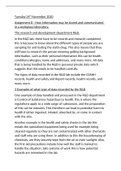Tuesday 24th November 2020
Assignment D - How information may be stored and communicated
in a workplace laboratory.
The research and development department R&D.
In the R&D lab, there have to be records and research completed,
this is because to know about the different types of people you are
sampling for and testing the statin drug. This also means that they
will have to research the person meaning getting background
information, such as their personal information this can be health
conditions/allergies, name and addresses, and many more. All data
that is being handled by the R&D is personal private data which
suggests that this needs to be handled carefully.
The types of data recorded in the R&D lab include the COSHH
records, health and safety and Report records, health records, and
many more.
3 Examples of what type of data recorded by the R&D
One example of data handled and processed in the R&D department
is Control of Substances hazardous to health, this is where the
regulations apply to a wide range of substances, and the preparation
of this can be mixtures. This therefore can lead to potential harm to
health if either ingested, inhaled, absorbed by, or come in contact
with the skin.
Another example is the health and safety checks in the lab this
entails the specialised equipment being used for example being
cleaned regularly so they are not contaminated with other chemicals
and staff who are using them. In addition to this the housekeeping of
chemicals, are they securely kept from the air or even sunlight. Also,
the first aid precautions include how well the staff is trained to
handle the situation. Safe systems of work this is how potential
hazards are minimised in the lab.
, Lastly, the Report records, for example, incidents need to be logged
correctly and actioned in line with the company policies and
procedures, this is therefore to improve and help develop health and
safety measures. (Hartley, J et al 2016)
Data processing example
One example of data processing of large data sets in the R&D
department is laboratory information management systems (LIMS).
This is where large amounts of information will be produced and this
is vital that the data can be stored correctly so this can be used later
when needed. Storage of records has changed since there has been a
significant improvement in technologies for example the arrival of
computers this, therefore, has replaced filing cabinets and large
boxes. As a consequence, hard drives and cloud have been
developed to secure the data stored and organisations may often use
this as a storage platform for important data records.
All processed data must be obliged to the general data protection
regulation this is known as GDPR. Certain legally bound
commitments now apply directly to the data processors and people
who control the data this also implies that all data handled needs to
be completed legally, confidentially, and safely. (Hartley, J et al 2016)
2 ways of how information can be communicated within the R&D.
In a scientific organisation there are several ways in which
information can be communicated for example companies may have
their intranet this is where only employees who work in the
establishment can access and edit the data by adding more details,
therefore contains information to do with the company and they
would be able to access a tool which would allow them to get on to
the web page quickly to get the relevant data needed. However
external companies may be invited to use the companies’ intranet
but will be only allowed access to some areas, this would be because




